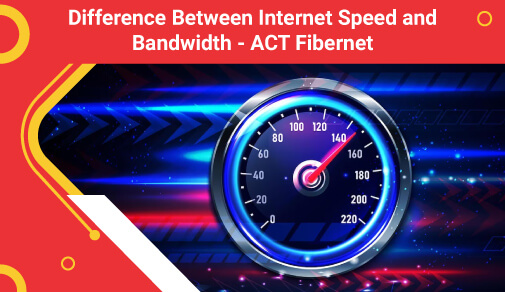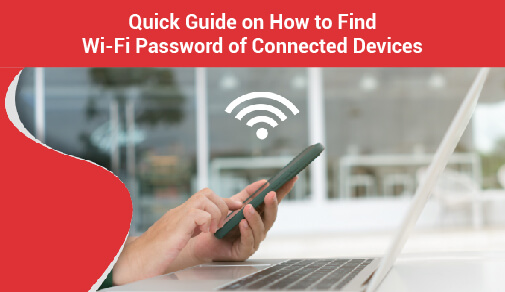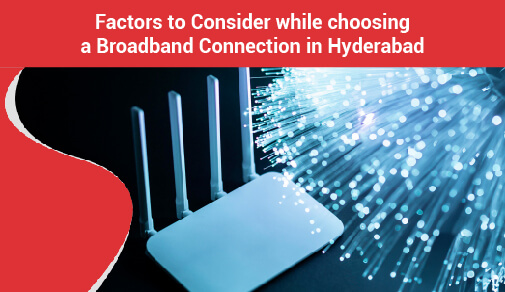Difference Between Internet Speed and Bandwidth
-
0
-
-
10 minutes

Internet speed and bandwidth are often interchangeably used in the common language. Though both these words are related, they do not mean the same thing. Bandwidth refers to the amount of data you can send over the internet at any given time. Speed is the speed of data transmission at a given moment.
Still confused? Le's put this in simpler words! Internet bandwidth means the maximum data your internet connection can handle. Internet speed refers to the rate at which the data is transferred. Speed is measured in Mbps (megabytes per second) or Gbps (gigabytes per second). Bandwidth is measured in GHz (gigahertz) or Bps (bits per second).
This article will explain the importance of speed and bandwidth. By understanding these concepts thoroughly, you can choose a perfect broadband internet plan.
Why Is it Important to Know about Internet Speed and Bandwidth?
Most ISPs (internet service providers) boast of providing a high-speed internet connection. However, your experience while using their internet services may be different. So, it becomes essential to check the bandwidth and speed that they are offering on paper.
Let me explain the subtle differences between these two terms through an example. You can image bandwidth as the road on which you drive a car. If there are more vehicles on the road, it leads to slow traffic or traffic jam. As a result, you may find it difficult to drive the car at a fast speed. Similarly, if there is more noise, you may get a slower broadband speed despite having a higher bandwidth.
With higher internet bandwidth, it becomes easy to connect multiple devices to the internet. These days, we prefer using Alexa, Google Home, and other smart devices. At the same time, we also use our home internet for watching movies, online shopping, or when working remotely.
With sufficient bandwidth, it is possible to connect smart devices to the internet. Connecting them with high-speed internet ensures that they function smoothly. Also, you may share your connection with your family and friends without facing any lags.
Speed is the data transfer rate that the ISP promises at the time of delivery. The network speed can be further classified into upload speed and download speed. Upload speed is the rate at which you can transfer data from your device to a server or cloud. Download speed is the rate at which your data gets transferred from the server to your device. A faster internet speed with equal upload and download speeds help you manage your work efficiently.
A low upload speed may not affect your overall experience. Yet, it matters to those who want to send large files or engage in live streaming. A slow download speed will delay your downloads and cause buffering while watching HD videos or playing games. Due to these reasons, confirm the internet bandwidth and speed you will be getting before subscribing to broadband internet.
Difference between Internet Bandwidth and Speed
ISPs offer plans with varying internet bandwidth and data limits. However, the actual speed will always be less than the bandwidth. Bandwidth is the maximum speed that you get at any given point.
To make an informed decision regarding the choice of internet type and speed, you must understand the subtle differences between the two. The below table should clear all your doubts regarding internet speed and bandwidth:
Bandwidth
Speed
The amount of data transferred for a specific time is called bandwidth
Internet speed measures the rate at which the data gets transferred.
Bandwidth is independent of factors like upload speed, latency, and download speed
Speed can be measured in terms of upload speed, latency, and download speed
Hz (hertz) or bps (bits per second) are the units in which bandwidth is measured
Speed is usually measured in Kbps, Mbps, or Gbps.
Bandwidth is always greater than speed
Speed is never higher than the internet bandwidth
Bandwidth helps you to determine the overall performance of the network
Speed helps you measure signal strength and find underlying network issues
Why Measure Internet Speed and Bandwidth?
Measuring network speed is essential due to the following reasons:
1. Optimising the network performance
Your internet may not perform as per your expectations. Network congestions, bottlenecks, downtimes, etc. are some of the issues that may degrade the speed of your network. Measuring the speed gives you an idea regarding the areas where your internet is lagging. You can upgrade your software or hardware settings to fix the speed issues.
2. Overall experience
Speed alters or improves your overall internet usage experience. If the speed is low, it leads to a poor experience. Measure the speed at different stages of data usage before deciding whether to switch the service provider or not.
3. Cost savings
Measuring speed can also help you control your internet costs. For example, if certain apps or upgrades are utilising bandwidth, you can restrict their data usage. It helps you save data and ultimately helps you manage your internet requirements at a lesser cost.
Network speed can be measured using speed test apps and websites. The internet speed also varies as per the connection type. For example, fibre internet offers much faster data speed as compared to traditional internet connection types. So, you can switch to a fibre-optic network if your existing speed does not match your requirements.
Measuring network bandwidth is essential due to these reasons:
1. User experience
Your overall internet usage experience will be better if the internet bandwidth is on the higher side. Some activities such as online gaming, live streaming, and downloading 4K videos require higher bandwidth. If the bandwidth is high enough, you will not face issues like buffering, gaming lags, etc. The web pages will load quickly and you can enjoy a smoother playback while watching online videos.
2. Scalability
A higher bandwidth also determines whether you can add more devices to your network. With higher bandwidth, multiple devices can access the internet without any lags or issues. Also, if the bandwidth is low, you won’t be able to add multiple users to your network. So, measuring bandwidth becomes essential in this aspect.
3. Business operations
Data-intensive activities such as adding large files over the cloud, video conferencing, and file sharing need high bandwidth. So, you must choose an ISP that offers higher bandwidth to ensure smooth business operations.
Network performance-checking applications, command-line tools, and hardware devices like switches and routers can be used to measure bandwidth.
Understanding Bandwidth vs Speed vs Throughput
Speed and bandwidth are theoretical concepts. ISPs use them to promote their internet services. However, the actual data your network manages to transfer is called throughput. Like speed, throughput is also measured in kilobytes per second or megabytes per second.
Suppose that your internet connection has a bandwidth of 50 Mbps. However, due to network congestion, you get a speed of only 25 Mbps. It means that the throughput is only 25 Mbps or 25 Mbps less than the expected speed. Congestion, packet loss, weather conditions, and other factors affect the network throughput.
Here is an example to explain the difference between speed and throughput. Suppose that a motor has the capacity of withdrawing 50 gallons of water from a well. Factors like water leakages in the pipe, electricity fluctuations, etc. can result in the withdrawal of only 30 gallons of water. It means that the actual capacity of the motor deteriorated in real-world conditions.
The same logic can be applied to speed and throughput. Speed is the theoretical data transfer rate you would get in ideal conditions. Yet, in a practical setting, weather, network transmitting devices, network traffic, etc. can cause the speed to slow down. This is what we refer to as throughput in technical terms. Though a normal user does not have to go into such details, it is important to understand these finer nuances while using a network speed tester.
How to Choose an Internet Connection by Determining Speed and Bandwidth?
All the above information is of no use if you do not know how to use them while buying a broadband internet plan. Most ISPs claim to provide high-speed internet connectivity at reasonable prices. You can check whether they deliver what is promised by measuring the network speed and bandwidth. Prioritise the below points while getting an internet connection:
1. Choose the right type of connection
You must evaluate your actual bandwidth requirements before buying a broadband plan. Your basic internet requirements can be fulfilled by DSL, cable, or satellite connection. However, if your bandwidth requirements are on the higher side, you can think of getting a fibre internet connection.
The thing that distinguishes a fibre-optic network from other types of connection is its way of transmission. A fibre-optic network is usually laid below the ground. Therefore, factors like weather conditions, temperature, humidity, etc. rarely have any effect on it. Also, it uses light pulses to transfer data from one point to another. As a result, the data transmission happens much more quickly. This is the same reason why fibre internet plans promise a greater bandwidth in comparison to other network types.
2. Investigate the SLA (service-level agreement)
Every service provider can boast of providing a high network speed and bandwidth. It is because these are theoretical terms and tall claims can be made just based on network infrastructure. The real question arises when issues like packet loss, network traffic, latency, and jitter affect your network quality.
Has your ISP mentioned handling these network issues in the SLA? If not, it is better to avoid getting the internet for them. Instead, choose ISPs that have a strong and comprehensive SLA in place.
3. Measure the latency, jitter, and packet loss
Latency refers to the time required for a data packet to reach your device from the server. Low latency means that your network performance is delivering what was promised at the time of getting the internet connection. Latency is measured in milliseconds and is often referred to as ping rate by internet providers. Certain tools and applications are designed to measure ping rates. Go for the provider that offers a lower ping rate.
Sometimes, the data packet fails to arrive at the destination due to poor signal, interference or noise, and other factors. If the packet losses are frequent, it leads to a poor user experience. Measures like switching from Wi-Fi to ethernet, restarting the router, changing ports, and so on can fix this issue.
Network congestion may send a data packet late. This is what we refer to as jitter. A certain level of jitter is acceptable in real-world situations. For example, to carry out a video streaming smoothly, the jitter should be less than 30 ms.
These are some things to look for while selecting a broadband internet plan. It is best to use fibre internet for a good overall experience. ACT Fibernet is the best service provider in tier 1 and tier 2 cities of India. As per Ookla, it is the fastest internet service in many parts of the country. Speeds of up to 1 Gbps can be easily availed through their internet connection!
If you want to buy internet for business requirements, explore ACT Fibernet's business broadband plans. A dedicated or leased line can resolve most of your network issues. For home internet needs, you can always go for their residential broadband plans.
Conclusion
Internet bandwidth and speed are the basic things that most internet users look for while getting an internet connection. The broadband speed may vary depending on connection type, location, and other factors. As a smart user, dig deeper than these basic terms. Check whether or not the internet plan you have delivers the promised speed and bandwidth.
Finally, find out whether the ISP is reputed in your area. You can pick the broadband internet plan for the ISP that has strong SLAs in place. Service providers like ACT Fibernet ensure that you get a high-speed data connection without minimal issues. Apart from faster internet, they also offer value-added services such as access to Disney+Hotstar, Zee5, SonyLiv, and other OTT platforms at no extra cost. Visit their website today and see how their fibre internet connection can transform your internet usage experience!







